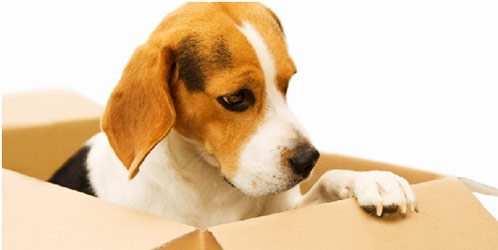Moving home is a stressful time for us but it can be even harder on our pets. A change of environment can often lead to them running away and also getting sick. It is important to ensure that the removal and relocating process is not only easy on you but also for your pets.
You need to set protocols in place to ensure that your pets do have a smooth transition between homes.
Things to do before the move with your pet
- Keep your pets’ routines, such as feeding and walks, as normal as possible in the week before moving. Because dogs and cats need to feel in control, they might exhibit behavioural changes or even become ill when stressed. Treat them with the same level of attention you would ordinarily give them.
- Visit your veterinarian a couple of weeks before moving. Request a copy of your pets history, a vaccination certificate and a de-sexing certificate. Be sure your pets are up to date with their shots.
- If your animal is staying with you during the move, then confine them to one secure room so that escape and injury cannot occur whilst people are going in and out of the house. Leave them in a quiet area with their familiar unwashed bed and possessions. Place the travel carrier in the room with the door open so your pet can adapt to it before travel day. On moving day, it might be an idea to board cats and dogs, or ask a friend to look after them for a few days. This will limit the amount of stress placed on your animal.
- Leave packing your pets toys, bedding and other equipment to the last moment so that they are comforted by the presence of familiar things. Do not wash bedding until a couple of weeks after the move, so that they will have something familiar smelling in the new house.
Travel checklist
Make sure you have the following before the move:
- Veterinary records, certificates, and recent photos
- Your pets usual foods and plenty of water from the home you’re leaving (changing the water source can be disorienting and upset their stomachs)
- Food and water bowls, a can opener and re-sealable lids
- Toys, chew bones and treats
- Leashes (both cats and dogs)
- Beds (pillows, towels or other crate liners)
- Plastic bags and scoops for dogs
- Litterbox for cats
- Cage covers for birds and rodents
- Paper towels for messes
- Provisions for the first day at the new home
If travelling a long way, prevent travel sickness by not feeding them for 12 hours before the journey. If you know your pet suffers from travel sickness, ask your vet about anti-sickness medications.
Things to remember during the move
- Put new identification tags on
- Make sure that your pet is safely secured in the car or vehicle that they are to be transported in to the new house.
- If it is a long journey, make sure that they get regular toilet and water breaks. Remember the temperature in a parked car can rise rapidly and your pets might die from the heat
In the new home
- Check the boundary fencing to make sure that it is secure, of sufficient height and ‘hole free’ before letting your dog run free in the garden. If your dog is able to escape then take him out on a lead until you are able to do the necessary improvements.
- Try to unpack the essentials before introducing your pet to the new house so that he can see familiar items within the unfamiliar house. If possible try to place furniture and items in similar places to those in the old house.
- In the new home, choose a small room to be the pet room, where they can feel secure as you move in furniture and belongings. As much as possible, have furniture, bowls, and toys in place before you let your pets out of their crates.
- Don’t let your pet outdoors without a leash until they’ve adapted to their new surroundings – several days to a week for cats, dogs adapt more quickly.
Continue giving your pets water from home for the first few days. - If your pets misbehave, consider ways to reduce their stress. If you suspect they may be ill, make an appointment with your vet. Don’t punish your pets for initial mis-behaviour. Cats especially will not understand and only cause them to distrust you. Be patient with your pet in the new home and make allowances for ‘accidents’ on the carpet if they should happen. Don’t make a fuss, punish your pet or draw attention to it as it may make the problem worse. Quietly pick up the mess and clean the area with a biological solution, or special cleaner from the vets to remove the smell. When your pet goes to the toilet in the correct area, praise them.
- If your animal is micro-chipped, remember to get their records changed to your new address.
- Make sure that you stick to your usual routines, as this will help them to settle, so feed and walk at the usual times. Don’t give more or less attention than they are used to having – this may cause them to become anxious or over dependent on you and lead to behaviour problems.
- To help your dog settle in take them for lots of walks. This will help your dog get used to their new surroundings.
Hopefully the above tips help to make you and your pets move a little more relaxed. However, it is important to remember that if you have ongoing issues with your pet, make sure to visit your veterinarian, as a medication (such as an anti-depressant) or behaviour retraining may be required.

